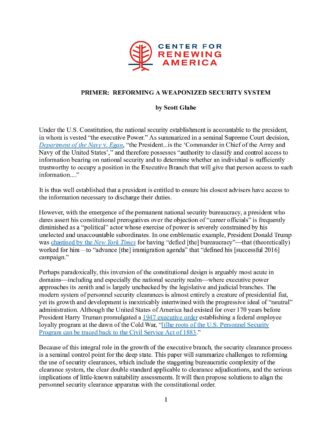
PRIMER: Reforming a Weaponized Security System
Under the U.S. Constitution, the national security establishment is accountable to the president, in whom is vested “the executive Power.” As summarized in a seminal Supreme Court decision, Department of the Navy v. Egan, “the President…is the ‘Commander in Chief of the Army and Navy of the United States’,” and therefore possesses “authority to classify and control access to information bearing on national security and to determine whether an individual is sufficiently trustworthy to occupy a position in the Executive Branch that will give that person access to such information….”
It is thus well established that a president is entitled to ensure his closest advisers have access to the information necessary to discharge their duties.
However, with the emergence of the permanent national security bureaucracy, a president who dares assert his constitutional prerogatives over the objection of “career officials” is frequently diminished as a “political” actor whose exercise of power is severely constrained by his unelected and unaccountable subordinates. In one emblematic example, President Donald Trump was chastised by the New York Times for having “defied [the] bureaucracy”—that (theoretically) worked for him—to “advance [the] immigration agenda” that “defined his [successful 2016] campaign.”
Perhaps paradoxically, this inversion of the constitutional design is arguably most acute in domains—including and especially the national security realm—where executive power approaches its zenith and is largely unchecked by the legislative and judicial branches. The modern system of personnel security clearances is almost entirely a creature of presidential fiat, yet its growth and development is inextricably intertwined with the progressive ideal of “neutral” administration. Although the United States of America had existed for over 170 years before President Harry Truman promulgated a 1947 executive order establishing a federal employee loyalty program at the dawn of the Cold War, “[t]he roots of the U.S. Personnel Security Program can be traced back to the Civil Service Act of 1883.”
Because of this integral role in the growth of the executive branch, the security clearance process is a seminal control point for the deep state. This paper will summarize challenges to reforming the use of security clearances, which include the staggering bureaucratic complexity of the clearance system, the clear double standard applicable to clearance adjudications, and the serious implications of little-known suitability assessments. It will then propose solutions to align the personnel security clearance apparatus with the constitutional order.
The Security Clearance System: Overview and Recent Developments
A 1995 executive order from President Bill Clinton, EO 12968, established the modern framework for access to classified information. Under EO 12968, “[a]gency heads shall be responsible for establishing and maintaining an effective program to ensure that access to classified information by each employee is clearly consistent with the interests of the national security.” EO 12968 further provides that federal executive branch employees “shall not be granted access to classified information unless they: (1) have been determined to be eligible for access…based on a favorable adjudication of an appropriate investigation of the employee’s background; (2) have a demonstrated need-to-know; and (3) have signed an approved nondisclosure agreement.”
Despite the overarching standards in EO 12968, the processing and adjudication of personnel security clearances is characterized by fragmentation, frequent organizational changes, and overlapping authority between and among federal agencies. Following a major 2015 data breach that “compromised [the] sensitive personal information…of roughly 21.5 million people,” primary responsibility for background investigations transferred from the Office of Personnel Management (OPM) to the Department of Defense (DoD) in 2019.
DoD’s Defense Counterintelligence and Security Agency (DCSA) performs background investigations–including interviews, often conducted by contractors–for 95 percent of the federal government, including more than 100 departments and agencies. Many of these departments and agencies are outside DoD. A background investigation informs a decision whether to grant a security clearance to a particular individual, known as an “adjudication.” Although DSCA conducts approximately 70 percent of government-wide adjudications, including for military service members, “[t]here are dozens of agencies that process clearances.”
Beyond DoD, as summarized in March 2023 congressional testimony, the Office of the Director of National Intelligence (ODNI) “[s]ets personnel vetting policy for determining access to national security (classified) information,” such as the 13 “adjudicative guidelines” for evaluating whether such access is “clearly consistent with the interests of national security …in the context of the whole person.” OPM “[s]ets personnel vetting policy for suitability, fitness, and credentialing determinations.” As discussed in further detail below, such determinations are generally required for all federal employees, including—but not limited to—those whose job duties also require a security clearance.
Additionally, the deputy director for management of the Office of Management and Budget (OMB) chairs a little-known interagency body—which includes senior representatives of DoD, ODNI, and OPM—known as the Security, Suitability, and Credentialing Performance Accountability Council (PAC). Established by a 2008 executive order, the PAC has in recent years focused on reducing a significant background investigation backlog. As a result, the average “end-to-end security clearance processing time” for a Top Secret security clearance has decreased from a staggering 414 days in Fiscal Year 2019 to a “sustainable” 128 days as of March 2023.
Since tackling the investigation backlog, the PAC has turned to broader reforms that are intended to “fundamentally improve the overall personnel vetting system,” which also portend continued complexity, dynamism, and opacity within the security clearance bureaucracy. Most notable is the ongoing “shift from periodic reinvestigations”—typically conducted every five years for Top Secret clearances—to “continuous vetting.” According to DoD, continuous vetting “is a process that involves regularly reviewing a cleared individual’s background”—including via “automated record checks [that] pull data from criminal, terrorism, and financial databases”—“to ensure they continue to meet security clearance requirements and should continue to hold positions of trust.” However, enrollees in continuous vetting will still be required to complete a burdensome standard form, known as an SF-86, every five years.
The umbrella initiative for the shift from periodic reinvestigation to continuous vetting is known as “Trusted Workforce 2.0” (TW 2.0). (In paradigmatic bureaucratic fashion, the “transitional phases” to reach TW 2.0 by late 2023 were christened TW 1.25 and TW 1.5.). Part of TW 2.0 is a new information technology system developed by DoD, including a new online application …for security clearance applicants” known as eApp.
Although TW 2.0 is a decidedly “inside the Beltway” topic, its impact is potentially wide-ranging. According to a recent article, “over four million Americans must hold security clearances to work.” Moreover, prospective political appointees in a future conservative administration must successfully navigate a human resources bureaucracy that zealously gatekeeps access to employment and classified information through enforcement of complex and ever-changing rules and procedures.
Exposing the Double Standard for Security Clearance Adjudications
Given the intricacies described above, it is unsurprising that the security clearance system has been frequently weaponized against those who wish to challenge the status quo. It is equally predictable that members in good standing of the Deep State seem to have few challenges obtaining and maintaining their access to classified information.
As noted in a previous paper, during the Trump administration, “several Republican national security officials experienced clearance difficulties that rarely seemed to resolve in their favor.” These included high-profile officials at the National Security Council, elsewhere in the White House, and at DoD. Meanwhile, House Democrats launched an investigation of those at the White House who did obtain clearances. “By contrast, among the subordinates with whom then-Secretary [of State Hillary] Clinton exchanged classified emails [on her private server] are current CIA Director William Burns and National Security Advisor Jake Sullivan—both of whom have managed to obtain and keep the highest clearances with virtually no public scrutiny.” Nor has there been a congressional inquiry, despite exhaustive details of the classified information on Clinton’s server having been provided to Congress in 2015-16.
More recently, two Federal Bureau of Investigation (FBI) whistleblowers were stripped of their security clearances (which at FBI inexorably leads to a suspension without pay) just before testifying to Congress in May 2023. One of the two lost his clearance at least in part for “send[ing] an email linking to a website stating that ‘federal law enforcement had some degree of infiltration among the crowds gathered at the Capitol’” on January 6, 2021. (For context, no less an establishment organ than the New York Times had reported in November 2022 that the FBI had “at least eight informants” in an organization whose members were charged with “seditious conspiracy” in connection with violence at the Capitol on January 6.) Although Presidential Personnel Directive-19, which prohibits retaliation against whistleblowers who are employees of an “Intelligence Community Element,” exempts the FBI, a number of longstanding laws prohibit retaliation against FBI whistleblowers. All too often, FBI has failed its whistleblowers, leaving them with virtually no recourse.
Given “the Executive’s nearly unchecked authority to deny, revoke, and suspend security clearances,” and the federal courts’ attendant refusal to review the merits of security clearance determinations, one might think that adverse clearance actions have been a potent tool in the hands of those who seek to rein in the national security state. However, when former President Trump threatened to revoke former Central Intelligence Agency chief and key architect of the Russia Hoax John Brennan’s clearance, distinguished commentators—including a former ODNI general counsel—suddenly opined that Brennan had a strong constitutional case.
Additionally, in August 2020, the chief executive officer of the U.S. Agency for Global Media (USAGM), a Senate-confirmed presidential appointee, sent letters to six senior USAGM executives “suspending their security clearance and placing them on administrative leave.” In September 2020, after their clearances were suspended, the six executives filed whistleblower complaints. After a change in administration, a USAGM “review team” found that the security clearance suspensions violated the whistleblower protections of PPD-19—even though PPD-19 only applies to “Intelligence Community Elements” (which does not include USAGM). The review team also faulted the CEO for failing to include anyone “trained in the adjudicative guidelines” in the suspension process, even though the CEO certified—consistent with EO 12968–that the suspensions were “in the interest of U.S. national security.” In the end, USAGM rescinded the proposed removals of all six executives on the second day of the Biden Administration, and those who returned to federal service retained their clearances. Voice of America, one of USAGM’s networks, gleefully reported the reappointments.
The Stealthy Scope of “Suitability” Determinations
Beyond the specific examples cited above, the bureaucracy and its political allies are preparing for the en masse weaponization of the security clearance process—and indeed of federal hiring writ large.
As a prerequisite to most federal hiring, and before a security clearance background investigation is initiated on a candidate for federal employment in a position requiring access to classified information, the candidate is subject to screening for “suitability” (in the case of positions in the competitive services) or “fitness” (for excepted service positions)—although “suitability” is often used colloquially to encompass both suitability and fitness determinations.
As one commentator recently opined, “suitability is the Wild West of federal hiring.” OPM has established existing government-wide criteria for making suitability determinations, which are similar though not identical to ODNI’s adjudicative guidelines for access to classified information. However, “each agency also has its own suitability guidelines.” Additionally, adverse suitability determinations are generally both unreviewable—due process protections governing denial or revocation of a security clearance generally “don’t apply to people who are disqualified for a job due to federal employment suitability or fitness standards”—and literally inexplicable— “if an agency withdraws a job offer for an excepted service position due to employment suitability reasons, they generally only inform you that you were found to be unsuitable for the position without providing any specific reasons.”
Given the finality and enigmatic nature of suitability, a little-known regulation proposed by OPM in January 2023 merits close scrutiny. The regulation seeks to replace an existing suitability factor—“[k]nowing and willful engagement in acts or activities designed to overthrow the U.S. Government by force”—with four new factors. One of the new factors closely tracks the existing one—“[k]nowing engagement in an act or activity with the purpose of overthrowing Federal, State, local, or tribal government.” The other three, which break new ground, are as follows:
- “An act of force, violence, intimidation, or coercion with the purpose of denying another individual the free exercise of rights under the U.S. Constitution or any state constitution”;
- “Attempting to indoctrinate another or to incite another to action in furtherance of an illegal act”; and
- “Active membership or leadership in a group with knowledge of its unlawful aim, or participation in such a group with a specific intent to further its unlawful aim.”
As some have noted, it is not difficult to imagine how these new factors could be weaponized against conservatives. For example, because some state constitutions have been interpreted to enshrine a right to abortion, attendance at a pro-life rally could be construed as “[a]n act of…intimidation…with the purpose of denying another individual the free exercise of rights under…[a] state constitution.” Moreover, the focus on organizations, as opposed to individual conduct, recalls the Cold War-era blacklist known as the “Attorney General’s List of Subversive Organizations.” As one former OPM director observed, conceivably “half of American voters [might] be ineligible for government employment under these new woke rules.”
The new OPM regulation would also apply these suitability criteria to “fitness determinations” for excepted service positions, which includes most intelligence community jobs. In sum, “nearly 7 million individuals receive some level of personnel vetting for the Executive Branch.” Although the proposed regulation “exclude[es] political appointees from its definition of the ‘excepted service’ for purposes of suitability and fitness,” the human resources bureaucracy might nonetheless attempt to subject political appointees to the same standards as everyone else. Moreover, the new criteria would generally apply to flexible hiring authorities that senior political appointees often leverage to quickly fill non-political positions with qualified applicants.
Additionally, the new proposed suitability criteria foreshadow similar changes to the “adjudicative guidelines” that govern security clearances. Legislation introduced in 2021 would have required OPM to modify its standard form for national security positions (SF-86) to include questions about whether the applicant “participate[d] in the activities occurring at the United States Capitol on January 6, 2021, or in any similar activity” or has “ever been a member of, associated with, or knowingly engaged in activities conducted by an organization or movement that spreads conspiracy theories and false information about the United States Government.”
Reforming the Security Clearance System
Thanks to a major motion picture, the 1954 administrative hearing that resulted in the revocation of the security clearance of physicist J. Robert Oppenheimer has once again been thrust into the public consciousness. Opposing Oppenheimer’s clearance revocation has long been a cause célèbre for liberals, culminating in a blockbuster film—and, before that, a 2022 Department of Energy order vacating the results of the 1954 hearing. Neither the order nor the film emphasize that, in a 1943 security questionnaire, Oppenheimer had written that he had “probably belonged to every Communist front organization on the West Coast.” Nonetheless, Major General Leslie Groves had ordered that Oppenheimer be given a clearance—even though Groves’s security officers “reported that they could not and would not clear him”—because Groves determined that Oppenheimer was the best person to direct the World War II Manhattan Project. Given the success of the project, history has largely vindicated General Groves’s judgment and exercise of authority.
The Oppenheimer case is perhaps an extreme example of the general principle that the security clearance process should serve, but not constrain, the interests of national security as defined by the president and executed by his duly-empowered subordinates.
In furtherance of such principle, a future presidential administration should:
Get the right people into the right national security positions as soon as possible after taking office.
Tools for achieving this objective include:
- Submitting requests for security clearances for prospective transition team members before the election, in accordance with applicable law.
- Making use of authority to grant interim security clearances, in accordance with applicable ODNI policy. (The current average processing time of 128 days for a Top Secret security clearance may be “sustainable” for the bureaucracy, but it is not fast enough for a new administration looking to implement a mandate from Day One.). The president should also direct the director of national intelligence (DNI) to review and revise such policy, including Security Executive Agent Directive 8, to permit more streamlined and longer-duration temporary access to classified information.
- Ensuring that the White House personnel security office is appropriately staffed and directed to swiftly adjudicate clearances pursuant to the president’s constitutional authority.
- Streamlining, eliminating, or waiving agency-specific suitability guidelines, as appropriate.
Issue day-one guidance to make crystal clear that agency heads may grant, suspend, or revoke security clearances—notwithstanding the recommendations of subordinates—if they determine that doing so is clearly consistent with the interests of national security.
As necessary, the president should also amend EO 12968 and/or direct the DNI to revise applicable ODNI policies, such as Intelligence Community Directive 704, in accordance with such guidance. Any agency head-level suspensions or revocations should, as a prudential matter, be drafted in close collaboration with trained security professionals and expressly rely on ODNI’s adjudicative guidelines. Doing so will, among other things, maximize the chances that the suspension/revocation of career officials’ clearances will be adjudicated via administrative channels by the Merit Systems Protection Board, rather than in federal court.
Leverage the Security, Suitability, and Credentialing Performance Accountability Council (PAC) to drive policy changes.
Among a panoply of other responsibilities, the OMB deputy director for management must prioritize personnel security clearances by regularly convening the PAC, ensuring the other PAC members (representatives of ODNI, OPM, and DoD) are aligned with presidential directives, and holding agencies accountable for the implementation of security clearance policies.
Quickly identify and train a cadre of staff to serve as liaisons between agency front offices and security staff.
Such training should be developed in collaboration with ODNI and qualify cadre members as “security personnel authorized by the agency head to make access eligibility determinations” within the meaning of EO 12968 and its implementing guidance. The goal of the liaison should be to assist agency heads in making adjudication decisions consistent with national security (and the foregoing recommendations), while ensuring that the process and documentation for such decisions are consistent with applicable law, regulation, and policy—including those prohibiting retaliation against whistleblowers. Liaisons should also actively identify rules that should be changed or updated in accordance with presidential and/or agency head direction and prerogatives.
Issue guidance regarding OPM’s new suitability and fitness regulation (if it takes effect before a change in administration).
This day-one guidance should ensure that suitability criteria and assessments are not implemented to infringe on constitutionally protected expression, or favor “woke” causes over conservative ones. Congress can assist by overruling (or, as applicable, rescinding) OPM’s regulation.
Pending a change in administration, Congress should immediately:
Conduct robust oversight of continuous vetting.
Congress must ensure that continuous vetting does not become a “Big Brother” companion to OPM’s “woke” suitability regulation and is not implemented to root out conservatives from federal employment.
Although any meaningful challenge to the bureaucracy is a daunting task, those seeking to reform the personnel security clearance process must be particularly prudent, knowledgeable, and courageous in the face of inevitable criticism.




